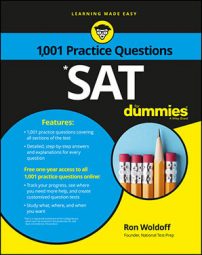Reading Passage
Questions 1 and 2 are based on the following information. Read the passage and answer each question based on information stated or implied in the passage.The following passage is an excerpt from GRE For Dummies, 8th Edition, by Ron Woldoff and Joe Kraynak (Wiley).
A key study has shown that the organic matter content of a soil can be altered to a depth of 10 cm or more by intense campfire heat. As much as 90 percent of the original organic matter may be oxidized in the top 1.3 cm of soil. In the surface 10 cm, the loss of organic matter may reach 50 percent if the soil is dry and the temperature exceeds 250 degrees. (1) The loss of organic matter reduces soil fertility and water-holding capacity and renders the soil more susceptible to compaction and erosion.Sandy soils attain higher temperatures and retain heat longer than clay soils under similar fuel, moisture, and weather conditions. From this standpoint, it is desirable to locate campgrounds in an area with loam or clay-loam soil. Sandy soils are less susceptible to compaction damage, however, and are more desirable for campgrounds from this standpoint.
(2) A water-repellent layer can be created in a soil by the heat from the campfire. This condition was noted only in sandy soils where the temperature remained below 350 degrees during the campfire burn. Campfires often produce temperatures above this level. By comparison, forest fires are a shorter-duration event, and soil temperatures produced are more likely to create water repellency-inducing conditions. The greater extent of forest fires makes them a more serious threat than campfires in terms of causing soil-water repellency.
If the soil remained moist for the duration of the campfire, the increased heat capacity of the soil and heat of water vaporization kept the soil temperature below 100 degrees. (3) At this temperature, little loss of organic matter occurred, and no water repellency was created. For areas where the soil remains very moist, campfires probably have little effect on the soil properties.
Studies show that softwood fuels burn faster and produce less heat flow into the soil than do hardwood fuels under the same conditions. Elm and mesquite were the hottest burning and longest lasting fuels tested. In areas where some choice of fuels is available, the use of softwood fuels should be encouraged in an effort to minimize the effect of campfires on soil properties.
By restricting the fire site to the same area, the effects of campfires on the soil in a campground can be lessened, even if permanent concrete fireplaces are not installed. In this manner, any harmful effects are restricted to a minimum area. If campfires are allowed to be located at random by the user, the harmful effects tend to be spread over a larger part of the campground. The placement of a stone fire ring in the chosen location is one way to accomplish the objective.
(4) These data support the decision to install permanent fireplaces in many areas and to restrict the use of campfires elsewhere in the park. This eliminates the harmful effects of campfires on the soil and allows the campground to be located on sandy soil with low compactibility and good drainage.
Practice questions
- The authors would be most likely to agree with which of the following? A. Campfires should be banned as destructive to campground soil. B. Organic matter decreases soil erosion. C. Clay-loam soil is preferable to sandy soil for campsites. D. Campfires will not burn in areas with moist soil.
- Which sentence best supports the answer to the preceding question? A. Sentence 1 ("The loss . . . erosion.") B. Sentence 2 ("A water-repellent . . . campfire.") C. Sentence 3 ("At this temperature . . . created.") D. Sentence 4 ("These data . . . the park.")
Answers and explanations
- The correct answer is Choice (B). The last sentence of the first paragraph states that the loss of organic matter reduces water-holding capacity and renders the soil more susceptible to erosion. Choice (A) is wrong because the authors support controlling campfires, not banning them. Choice (C) is wrong because the discussion is on the campfires, not the campsites. Choice (D) is wrong because campfires do burn on moist soils.
- The correct answer is Choice (A). This sentence states that the loss of organic matter makes the soil more susceptible to erosion.

